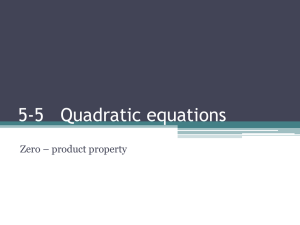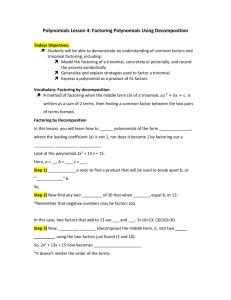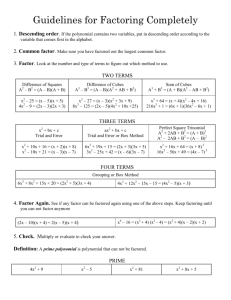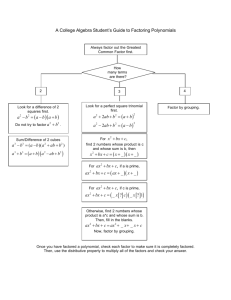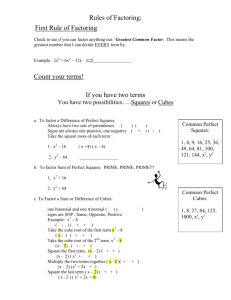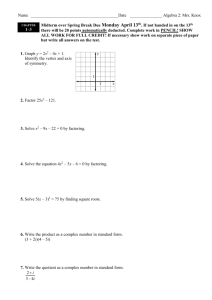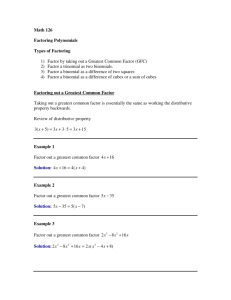MATH 108 – REVIEW TOPIC 4 Factoring Introduction. Factoring is a
advertisement
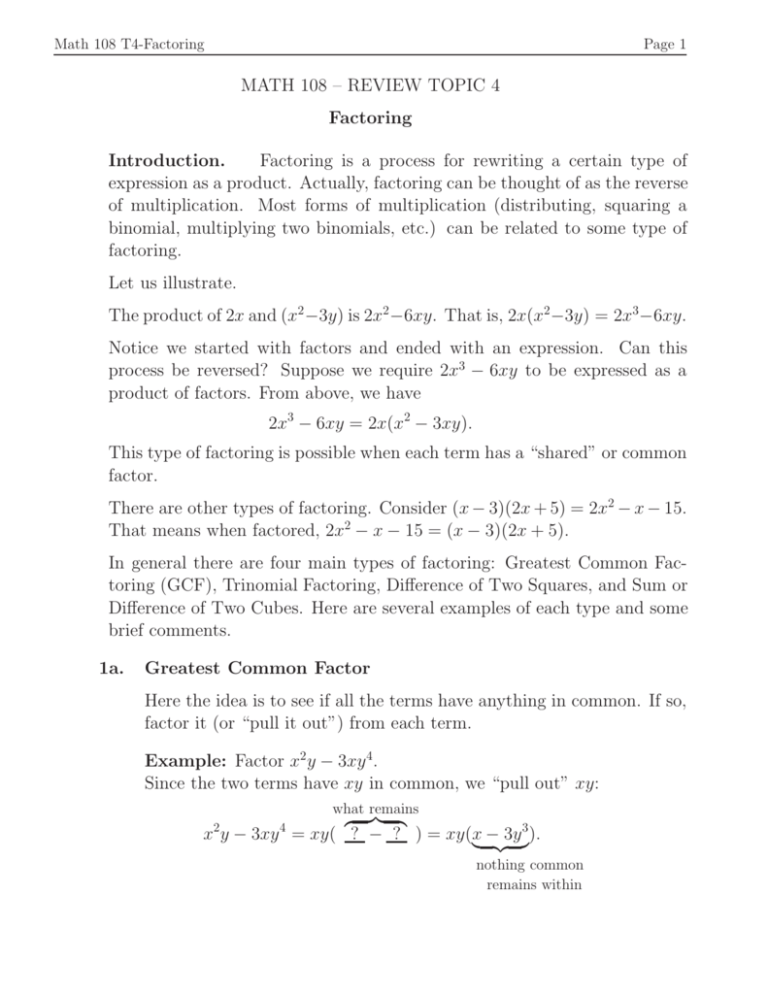
Math 108 T4-Factoring
Page 1
MATH 108 – REVIEW TOPIC 4
Factoring
Introduction.
Factoring is a process for rewriting a certain type of
expression as a product. Actually, factoring can be thought of as the reverse
of multiplication. Most forms of multiplication (distributing, squaring a
binomial, multiplying two binomials, etc.) can be related to some type of
factoring.
Let us illustrate.
The product of 2x and (x2 −3y) is 2x2 −6xy. That is, 2x(x2−3y) = 2x3 −6xy.
Notice we started with factors and ended with an expression. Can this
process be reversed? Suppose we require 2x3 − 6xy to be expressed as a
product of factors. From above, we have
2x3 − 6xy = 2x(x2 − 3xy).
This type of factoring is possible when each term has a “shared” or common
factor.
There are other types of factoring. Consider (x − 3)(2x + 5) = 2x2 − x − 15.
That means when factored, 2x2 − x − 15 = (x − 3)(2x + 5).
In general there are four main types of factoring: Greatest Common Factoring (GCF), Trinomial Factoring, Difference of Two Squares, and Sum or
Difference of Two Cubes. Here are several examples of each type and some
brief comments.
1a.
Greatest Common Factor
Here the idea is to see if all the terms have anything in common. If so,
factor it (or “pull it out”) from each term.
Example: Factor x2 y − 3xy 4.
Since the two terms have xy in common, we “pull out” xy:
what remains
z }| {
x y − 3xy = xy( ? − ? ) = xy(x − 3y 3).
| {z }
2
4
nothing common
remains within
Math 108 T4-Factoring
Page 2
Example: 2(a + b)2 + 6(a + b)3 = 2(a + b)2[ ? + ? ]
= 2(a + b)2[1 + 3(a + b)]
= 2(a + b)2(1 + 3a + 3b).
Example: a1/3 − 4a4/3 = a1/3( ? − 4 ? ) = a1/3(1 − 4a)
Notice from these last two examples that even when the common factor
is a “quantity” or contains fractional exponents, the process is the same.
Namely, remove as much common “stuff” as possible and leave the rest.
1b.
Grouping
A special type of common factoring is referred to as “grouping”. This
usually involves four terms with two steps of common factoring.
Example:
x3 − 2x2 + 4x − 8 = (x3 − 2x2) + (4x − 8)
= x2 (x − 2) + 4(x − 2)
= (x2 + 4)(x − 2)
Group in pairs
Try a different grouping (possibly x3 +4x − 2x2 − 8) and see what result
you get.
IMPORTANT: As in all factoring problems, multiplying the factors
should yield the original expression. This is a good way to check if
your factoring is correct.
Exercise 1: Factor each:
a) 12x3y − 18x2y 2 − 24x5
Answer
b) x2/3 + 2x5/3
Answer
c) 3(x + 2)−1/2 + x(x + 2)1/2
Answer
d) 2x3 − 6x2 − 5x + 15
Answer
Math 108 T4-Factoring
2a.
Page 3
General Trinomials
By this time you’ve done “hundreds” of problems requiring you to multiply two binomials (usually called FOIL). Trinomial factoring requires
similar thinking, only in reverse. In particular, you must select and
arrange the terms in each factor so that the outer and inner products
have a sum equal to the middle term.
Here are some examples.
x2
x2 y 2
x4
4x2
4x2
− 7xy + 10y 2
− 3xy − 10
− 9x2 − 10
+ 16x + 15
− 17x − 15
= (x −
= (x −
= (x2 −
= ( )x +
= ( )x +
y) (x −
) (xy +
) (x2 +
( )x +
( )x −
y) = (x − 2y) (x − 5y)
) = (xy − 5) (xy + 2)
) = (x2 − 10) (x2 + 1)
= (2x + 5) (2x + 3)
= (4x + 3) (x − 5)
Note: A test for factorability of a trinomial is shown in the answer to
Exercise 2.
2b.
Perfect Square Trinomials (PST)
There’s a special trinomial that results when any binomial is squared.
Recall (a ± b)2 = a2 ± 2ab + b2. Therefore any trinomial that matches
this distinct pattern factors into the square of a binomial.
Illustration:
x2 − 6x + 9 = (x − 3)2
25x2 + 30xy + 9y 2 = (5x + 2y)2
because − 2(x)(3) = −6x
because 2(5x)(3y) = 30xy
If the middle term does not satisfy this “2ab” condition, the trinomial
still may factor as a general trinomial.
Example: 4x2 − 29x + 25
This is not a PST. The first and third terms have the form a2 and b2,
but the middle term is not of the form −2(2x)(5) = −20x. However it
still factors.
Ans: 4x2 − 29x + 25 = (4x − 25)(x − 1)
Math 108 T4-Factoring
Page 4
Exercise 2: Factor each:
a) x2 − 72x + 20
(e) 2x2 − 11x + 15
b) x2 − 21x6y + 20y 2
(f) 2x4 − 7x2 − 15
c) x2 − 9x − 20
(g) 4x2 + 12x + 9
d) x2 − 10x + 25
(h) 4x2 − 13x + 9
(i) x2n − 3xn − 4
3.
Answers
Difference of Two Squares
This is probably the easiest type of factoring to recognize. It follows a
distinct pattern.
a2 − b2 = (a − b)(a + b)
Example:
9x2 − 25 = (3x)2 − (5)2 = (3x − 5)(3x + 5)
4x6 − 49 = (2x3)2 − (7)2 = (2x3 − 7)(2x3 + 7)
WARNING!! Watch out for expressions of the form a2 + b2.
Common error: x2 + 16 = (x + 4)2 is not true.
Squaring a binomial yields a middle term of the form 2ab.
(x + 4)2 = x2 + 8x + 16
That means x2 + 16 (or the sum of any two squares) is nonfactorable.
Exercise 3: Factor each:
a) 9 − 4x2
(d) x6 − 100
b) a2 b4 − 16
(e) x2 − 5
c) x2 + 25
Answers
Math 108 T4-Factoring
4.
Page 5
Sum or Difference of 2 Cubes
Let’s begin by finding the following products.
a) (x − 3)(x2 + 3x + 9)
b) (x2 + 2)(x4 − 2x2 + 4)
Did you get a) x3 − 27 and b) x6 + 8?
This means x3 − 27 factors into (x − 3)(x2 + 3x + 9) and x6 + 8 into
(x2 +2)(x4 −2x2 +4). Notice that x3 −27 and x6 +8 represent a difference
or sum of 2 cubes: x3 −27 = (x)3 −(3)3 and x6 +8 = (x2)3 +(2)3. Maybe
the secret to cube factoring will come from analyzing these products?
How does the product of a binomial and trinomial yield only 2 terms?
Let’s examine our first product:
3x2
−3x2
(x − 3)(x2 + 3x + 9)
−9x
+9x
Because two pairs of “like” terms sum to 0, the only terms remaining
in the final answer come from
−27
(x − 3)(x2 + 3x + 9) = x3 − 27
x3
The key to cube factoring is found in these products.
Exercise 4: Below are products of binomials and trinomials. Each
product results in a sum or difference of two cubes. Fill in the blanks.
a) (x − 2)(x2 + ? + 4) = x3 − 8
b) (2x + 1)(4x2 − ? + ? ) = 8x3 + 1
c) (a3 − b3) = (a − b)( ? + ? + ? )
d) (x3 + 125y 3) = ( ? + ? )(x2 − ? + ? )
You should now be ready (if not eager) to factor cubes.
Answers
Math 108 T4-Factoring
Page 6
Example: Factor x3 + 1.
x3 + 1 = (x)3 + (1)3
“Sum of cubes”
−x2
x2
= (x + 1)(x2 + ? + 1) = (x + 1)(x2 − 1x + 1)
−1x
+1x
only x3 + 1 remains
Example: Factor 8x3 − 27.
8x3 − 27 = (2x)3 − (3)3
“Difference of cubes”
12x2
= (2x − 3)(4x2 + ? + 9) = (2x − 3)(4x2 + 6x + 9)
−12x2
NOTEWORTHY:
* The trinomial can’t be factored. Verify by applying the test for
factorability (b2 − 4ac).
** The common error mentioned before (with squares) still applies.
x2 + 16 6= (x + 4)2
x3 + 27 6= (x + 3)3
Expanding (x + 4)2 yields 3 terms
Expanding (x + 3)3 yields 4 terms
*** To avoid factoring mistakes, check by multiplying.
Exercise 5: Factor:
a) a3 b3 − 8
b) x6 + 64
Answers
Math 108 T4-Factoring
II.
Page 7
Guidelines for Factoring
The real challenge in factoring is twofold: recognizing which type to use and
mixed factorizations (more than one type involved). Start by looking for
the common factor, then proceed according to the number of terms.
GCF
als
omi
Trin
ials
om
n
i
B
General
b2 − 4ac tests
factorability
Squares
a2 − b2
4 Ter
ms
Grouping
PST
a ± 2ab + b2
2
Cubes
a3 − b3
Here are four examples. Notice how we follow this strategy.
Ex.
Ex.
Ex.
50x − 2x3 = 2x(25 − x2 )
= 2x(5 − x)(5 + x)
4y 3 − 10y 2 − 6y = 2y(2y 2 − 5y − 3) ⇒ b2 − 4ac = 49
= 2y(2y + 1)(y − 3)
x6 − 7x3 − 8 = (x3 + 1)(x3 − 8)
= (x + 1)(x2 − x + 1)(x − 2)(x2 + 2x + 4)
Ex. x2 + 4x + 4 − 9y 2 =
=
=
=
(x2 + 4x + 4) − 9y 2
(x + 2)2 − 9y 2
(x + 2)2 − (3y)2
[(x + 2) − 3y][(x + 2) + 3y]
GCF
Dif of 2
GCF
Gen. Tri.
Gen. Tri.
Cubes
3-1 Grouping
PST
Dif of 2 sq.
It is important that you master factoring. In the review topics that follow,
note how often factoring is used and for what purposes.
Math 108 T4-Answers – Factoring
Page 8
PRACTICE PROBLEMS for Topic 4
4.1. Factor completely.
a) 2x2(x + 1)3 + 5x(x + 1)2
Answer
b) −2x3 − 6x2 + 8x
Answer
c) 2x2 + x − 21
Answer
d) 4x2 − 5x − 6
e) 4x2 − 5x + 6
Test for factorability
using b2 − 4ac.
Answer
Answer
f) x4 − 10x + 9
Answer
g) x6 − 1
Answer
h) x3 + 3x2 − 4x − 12
Answer
i) x6 − 7x3 − 8
Answer
Math 108 T4-Answers – Factoring
Page 9
ANSWERS to PRACTICE PROBLEMS (Topic 4–Factoring)
4.1.
a) x(x + 1)2(2x + 5)
Return to Problem
b) −2x(x2 + 3x − 4) = −2x(x + 4)(x − 1)
Return to Problem
c) (2x + 7)(x − 3)
Return to Problem
Middle term: −6x + 7x = x
d) b2 − 4ac = 121 = 112 guarantees factors.
(4x + 3)(x − 2)
Return to Problem
e) b2 − 4ac = −71; Nonfactorable or prime.
Return to Problem
f) (x2 − 9)(x2 − 1) = (x − 3)(x + 3)(x − 1)(x + 1)
Return to Problem
g) As Difference of Cubes:
(x2)3 − (1)3 = (x2 − 1)(x4 + x2 + 1)
= (x − 1)(x + 1)(x4 + x2 + 1)
As Difference of Squares:
(x3)2 − (1)2 = (x3 − 1)(x3 + 1)
= (x − 1)(x2 + x + 1)(x + 1)(x2 − x + 1)
Comment: It is unusual that 2 correct methods “appear” to give different results. This means x4 + x2 + 1 = (x2 + x + 1)(x2 − x + 1). Try
to find a way to factor x4 + x2 + 1, we dare you.
Return to Problem
h) x2(x + 3) − 4(x + 3) = (x2 − 4)(x + 3) = (x − 2)(x + 2)(x + 3)
Return to Problem
i) (x3 − 8)(x3 + 1) = (x − 2)(x2 + 2x + 4)(x + 1)(x2 − x + 1)
Return to Problem
Beginning of Topic
108 Skills Assessment
Math 108 Exercise 1 – Topic 4
Factor each:
a) 12x3y − 18x2y 2 − 24x5
b) x2/3 + 2x5/3
c) 3(x + 2)−1/2 + x(x + 2)1/2
d) 2x3 − 6x2 − 5x + 15
Answers:
a) 6x2(2xy − 3y 2 − 4x3)
b) x2/3(1 + 2x)
c) (x + 2)−1/2[3 + x(x + 2)] = (x + 2)−1/2(x2 + 2x + 3)
d) 2x2(x − 3) − 5(x − 3) = (2x2 − 5)(x − 3)
Return to Review Topic
Page 10
Math 108 Exercise 2 – Topic 4
Page 11
Factor each:
a) x2 − 72x + 20
(e) 2x2 − 11x + 15
b) x2 − 21x6y + 20y 2
(f) 2x4 − 7x2 − 15
c) x2 − 9x − 20
(g) 4x2 + 12x + 9
d) x2 − 10x + 25
(h) 4x2 − 13x + 9
(i) x2n − 3xn − 4
Answers:
a) (x − 10)(x − 2)
b) (x − 20y)(x − y)
c) Prime
d) (x − 5)2
e) (2x − 5)(x − 3)
f) (2x2 + 3)(x2 − 5)
g) (2x + 3)2
h) (4x − 9)(x − 1)
i) (xn − 4)(xn + 1)
Maybe your trinomial factoring is already good. Here is how it can get
better.
How to test a trinomial for factorability:
Given any trinomial in the form ax2 + bx + c, evaluate b2 − 4ac.
i) If b2 − 4ac = 0, the trinomial is a PST ⇒
ii) If b2 − 4ac is a perfect square (1, 4, 9, . . . ) then the trinomial
factors as a general trinomial.
iii) All other values indicate the trinomial is non factorable.
Return to Review Topic
Math 108 Exercise 3 – Topic 4
Page 12
Factor each:
a) 9 − 4x2
(d) x6 − 100
b) a2 b4 − 16
(e) x2 − 5
c) x2 + 25
Answers:
a) (3 − 2x)(3 + 2x)
b) (ab2 − 4)(ab2 + 4)
c) Prime
d) (x3 − 10)(x3 + 10)
e) Prime
√
√
√
Comment: (x− 5)(x+ 5) = x2 −( 5)2 = x2 −5? Shouldn’t that mean
x2 − 5 is factorable? Yes and No. If we factor over the integers, x2 − 5 is
not factorable. If √
we factor√over the reals (which include roots) then x2 − 5
factors into (x − 5)(x + 5).
Illustration: Factor x − 10 over the reals.
√
√
√
√
Ans: ( x − 10)( x + 10).
Return to Review Topic
Math 108 Exercise 4 – Topic 4
Page 13
Below are products of binomials and trinomials. Each product results in a
sum or difference of two cubes. Fill in the blanks.
a) (x − 2)(x2 + ? + 4) = x3 − 8
b) (2x + 1)(4x2 + ? + ? ) = 8x3 − 1
c) (a3 − b3) = (a − b)( ? + ? + ? )
d) (x3 + 125y 3) = ( ? + ? )(x2 + ? + ? )
Answers:
a) (x − 2)(x2 + 2x + 4)x3 − 8
b) (2x + 1)(4x2 − 2x + 1) = 8x3 + 1
c) (a3 − b3) = (a − b)(a2 + ab + b2)
d) x3 + 125y 3 = (x + 5y)(x2 − 5xy + 25y 2)
In each of the problems, the sign between the terms of the binomial factor
matches the sign between the two cube terms in the result.
Return to Review Topic
Math 108 Exercise 5 – Topic 4
Page 14
Factor:
a) a3 b3 − 8
b) x6 + 64
Answers:
a) a3 b3 − 8 = (ab)3 − (2)3
= (ab − 2)(a2b2 + 2ab + 4)
b)
x6 + 64 = (x2)3 + (4)3
= (x2 + 4)(x4 +
+ 16)
= (x2 + 4)(x4 − 4x2 + 16)
There are other ways to find the trinomial factor. There is a formula,
a3 ± b3 = (a ± b)(a2 ∓ ab + b2).
Long division also works. In Exercise b), x2 + 4 x6 + 64 yields the
quotient, and other factor, x4 − 4x2 + 16. Isn’t this to be expected?
You’ve known about the factor/division relationship since your earliest
days learning arithmetic facts.
Return to Review Topic
